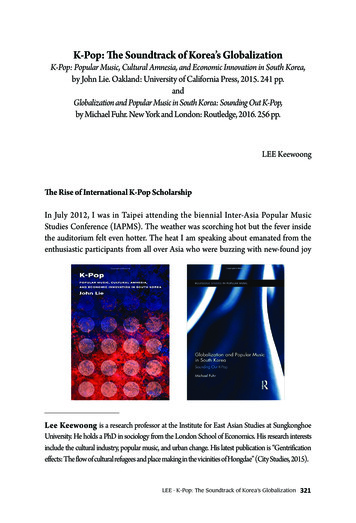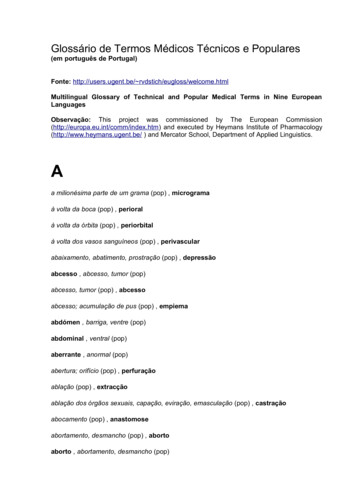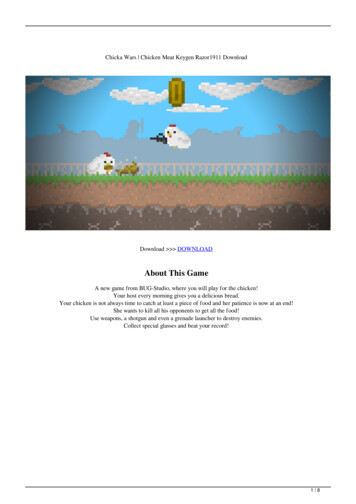
Transcription
K-Pop: The Soundtrack of Korea’s GlobalizationK-Pop: Popular Music, Cultural Amnesia, and Economic Innovation in South Korea,by John Lie. Oakland: University of California Press, 2015. 241 pp.andGlobalization and Popular Music in South Korea: Sounding Out K-Pop,by Michael Fuhr. New York and London: Routledge, 2016. 256 pp.LEE KeewoongThe Rise of International K-Pop ScholarshipIn July 2012, I was in Taipei attending the biennial Inter-Asia Popular MusicStudies Conference (IAPMS). The weather was scorching hot but the fever insidethe auditorium felt even hotter. The heat I am speaking about emanated from theenthusiastic participants from all over Asia who were buzzing with new-found joyLee Keewoong is a research professor at the Institute for East Asian Studies at SungkonghoeUniversity. He holds a PhD in sociology from the London School of Economics. His research interestsinclude the cultural industry, popular music, and urban change. His latest publication is “Gentrificationeffects: The flow of cultural refugees and place making in the vicinities of Hongdae” (City Studies, 2015).LEE · K-Pop: The Soundtrack of Korea’s Globalization321
about K-Pop. The official theme of the event was, “Ways of Listening: How Do WeListen to Pop Music in/from Asia, and How Can We Talk about It?” Though theconference intended to cover the music of Asia in general, the star of the show was,without a doubt, K-Pop. Thirteen of the sixty-four papers presented at the conferencewere devoted to K-Pop or its related topics, and there were a number of other paperswhich covered non-K-Pop Korean popular music such as rock and trot. It was adramatic change from the previous conference, held two years before, where the sumtotal of papers on the Korean Wave, not specifically K-Pop, was three. Personally, Iremember the 2012 IAPMS Conference as the moment when international K-Popscholarship exploded.K-Pop is now a staple in the international conference circuit, particularly in thedisciplines of Popular Music Studies and Korean Studies. In fact, we may even go sofar as to claim K-Pop scholarship as a crowded field, inundated as it is with literaturecovering the many dimensions of the topic. Specifically, there have been studies ongender (Jung 2011; Maliangkay and Song 2015), race (Liew 2013) national identity( Jung 2015; Khoo 2015), language (Lee 2004; Jin and Ryoo 2014), the musicindustry (Epstein 2015; Kang 2015; Kim 2015), media (Oh and Park 2012; Ono andKwon 2013), and fan culture (Siriyuvasak and Shin 2007; Khiun 2013; Sung 2013;Choi and Maliangkay 2015), to list but a few in English. Increasingly diverse topicsare being covered and debated. This makes K-Pop a tricky subject as it is becomingincreasingly difficult to say something that has not already been said. This is thefirst hurdle any new K-Pop literature needs to clear. Despite the great interest in thetopic, it is still true that international K-Pop scholarship remains in its infancy, as thedearth in English-language book-length expositions on the topic testifies. Until veryrecently, K-Pop: Roots and Blossoming of Korean Popular Music (2012) by Kim Changnam was the only authoritative and systematic account of K-Pop apart from popularguidebooks (e.g. Russell 2014) and edited volumes (e.g. Choi and Maliangkay 2015).In this circumstance, John Lie’s K-Pop: Popular Music, Cultural Amnesia, andEconomic Innovation in South Korea (shortened to K-Pop in this article) and MichaelFuhr’s Globalization and Popular Music in South Korea: Sounding Out K-Pop (shortenedto Sounding Out), the two books reviewed here, are welcome additions to the hithertoscant K-Pop bibliography. Both Lie and Fuhr are of Korean descent. The former isa Korean-American scholar of sociology who grew up in Korea, Japan, and Hawaii,whereas the latter is a German ethnomusicologist with a Korean mother and wasbrought up in Germany. The authors’ dual identities render them ideally positioned toplay the role of cultural translators, as they are acquainted with the cultures concerned.322Journal of Contemporary Korean Studies 3(1-2) · 2016
To an extent, that is indeed the role they perform with their books–transferringwhat is considered an aspect of Korean culture to a target audience of Anglophone,presumably non-Korean, academics and intellectuals. Both authors appear competentin the job. They are at once knowledgeable of Korean history and culture, and have asense of the demands of their target audiences. While Korean authors sometimes findit difficult to engage foreign readers since they tend to be too fixated on local interestsand agenda, Lie’s and Fuhr’s keen understanding of their readership is certainlybeneficial for initiating a new dialogue on the subject.However, the work of cultural translation is far from straightforward. In the casesof K-Pop and Sounding Out, there are two concerns. First, both authors exposethemselves as non-experts on Korean popular music. Popular music is very difficult tostudy for newcomers because of its ephemerality. It is music of here and now alwayssubject to oblivion. This means the field of popular music is rife with misinformation,wrong memories, and ungrounded rumors. Furthermore, popular music feeds onmyths. The past is constantly reconstructed and re-remembered. Without a certainamount of expertise, it is very difficult to distinguish reliable sources from those thatare not. In this respect, it is not surprising to find so many errors in their accounts ofKorean popular music, particularly in the historical details. Second, the in-betweenposition of our two authors does not mean neutrality. They have their own issues totackle and agenda to pursue with regard to their identities. To an extent, these issuesand agenda dictate the contents of the books. For example, Fuhr’s discussion on mixedethnicity in Korean pop music (Fuhr 2016, 199-202) is off-topic since this has notbeen an issue thus far in what is normally called K-Pop. Fuhr’s discussion is more anoutcome of the author’s desire to talk about it than it is relevant to the theme.As two books handling the same subject matter, K-Pop and Sounding Out cannot bemore different. K-Pop is a highly opinionated and at times insightful essay-style offeringcentered in theoretical speculation. It locates K-Pop in Korea explaining it in terms ofthe country’s history and internal dynamics, and focuses on K-pop as a cultural text,painstakingly debating its artistic merits and values. In contrast, Sounding Out is morea textbook account of K-Pop, an empirical analysis rooted in extensive and rigorousfieldwork as it is based on the author’s doctoral thesis. It conceptualizes K-Pop as aflowing cultural form, an outcome of transnational mobility and cooperation, andattempts to draw a larger picture of K-Pop as a global cultural phenomenon by analyzingthe multiple layers of its construction. In these respects, these two books can be seen ascomplementary to each other, shedding light on different aspects of the phenomenon.With some reservations, which I will go into in the remaining parts of this review, bothLEE · K-Pop: The Soundtrack of Korea’s Globalization323
books can serve as good starting points for in-depth understanding of K-Pop. In fact,there are few alternatives at the moment for the English readership. In the followingsections, I will discuss each book’s handling of K-Pop in more detail.Subverting the Aesthetic HierarchyFrankly, the first impression of Lie’s K-Pop is not very positive. Despite its title, firstof all, there is only one chapter that discusses K-Pop, and the length of the chapteris sixty-six pages, just one-fourth of the entire volume. Long preceding chapters onthe history of Korean popular music and Korea makes it feel as though two-thirdsof the book is introduction. Furthermore, as I mentioned earlier, these chapters arereplete with errors. I gave up counting inaccurate facts and misjudgments after justfirst twenty pages. Lie claims, for example, after the marijuana scandal in 1975, that“until the mid-1980s, rock music was silenced in the South Korean soundscape” (Lie2015, 46). He obviously ignored Sanullim’s sensational debut in 1977, SaranggwaPyeonghwa’s the next year, and the explosion of campus group sounds from 1977 to1980. Contrary to his claim, the late 1970s was a heyday for rock music in Korea. Lie’serror-strewn lecture on the history of Korean popular music goes on and producessome unintentionally hilarious examples: “Kim Hyŏn-sik distinguished himself withsongs of his own composition” (Lie 2015, 52); “Shinchon Blues were a minjung kayooutfit” (Lie 2015, 53); “repression of rock music made young people listen to rockmusic on short-wave radio” (Lie 2015, 54); “For an ear attuned to the post-Sŏ (SeoTaiji) period, Yi Sŏn-hŭi or Yi Mun-se might as well have been trot singers” (Lie 2015,59). He also speaks of Hyeuni as Hye and as a trot singer (Lie 2015, 50), when Hye isnot her surname and she is not a trot singer.Lie is said to have grown up in Japan and it shows as he relies heavily on Japanesesources for this book. Perhaps he might feel more comfortable with the Japaneselanguage than Korean. In my view, however, it was a fatal mistake since most of hiserroneous claims came from Japanese sources. Furthermore, I find his use of Japanesenomenclature for Korean persons and song titles deeply disturbing. He refers toCho Yong-pil’s hit song, “Dol-awayo Pusanhang-e” (Come back to Pusan Harbor)as “Fuzanko e Kaere,” its Japanese title (Lie 2015, 43); idol group Dong Bang Shin Gias Tōhō Shinki (Lie 2015, 105); and composer and saxophonist Gil Ok Yun by hisautonym Ch’oe Chi-jŏng (which he spells incorrectly, Ch’oe Chi-Sŏng is correct)and by his Japanese name Yoshiya Jun (Lie 2015, 44). In the last case, it is his stage324Journal of Contemporary Korean Studies 3(1-2) · 2016
name—Gil Ok Yun—by which he is known in Korea, but Lie does not mentionthat a single time. Although I understand and am willing to ignore faults and errorsin historical details, mistakes of this kind are difficult to turn a blind eye to. These arenot just oversights but a matter of scholarly integrity. Unless this book was writtenfor Japanese readers, which it does not appear to be, the author should have done abasic check. It is incredible that Lie thought it was fine to address Korean people bytheir Japanese names, particularly when those names are not used outside Japan. Evenif the book contained great ideas and insights, grave negligence like this tarnishes itsreputation and leaves a bitter taste in the mouths of readers.Thankfully, the chapter on K-Pop shows a significantly lower error rate. Thistime, however, the chapter is marred by poor organization. The chapter titled “SeoulCalling” is divided into seven sections. The length of each section is uneven and somelonger sections are crammed with too many topics. In the section called “Internal andexternal transformation” (Lie 2015, 130-136), for example, the author charts changesin Korean culture during the last thirty years to explain the global rise of K-Pop. Hetouches on everything from the noraebang or karaoke craze, Confucian ideology,competitive and meritocratic schooling, and plastic surgery to copyright protection,the spread of Western musical conventions, globalization and consumerism, and theKorean Wave–all in six pages! Inevitably, the account is superficial and unfocused,revealing that the author does not have much to say about K-Pop in detail. Thereis also a vague thematic relationship between sections in that they do not seemcoherently linked but arbitrarily placed. It is difficult to understand why some sectionsare there, such as one on Japan and J-Pop (Lie 2015, 136-140). Even though I tried, Istill do not know the function of this section with regard to the thesis of the book. Itonly serves to distract the reader’s attention.With my complaints out of the way, which I realize are many, I will now concentrateon assessing the book’s accounts and key arguments. It is instructive to start withrecapitulating Lie’s encounter with K-Pop, which he notes at the beginning of thebook. What we see here is a typical reaction from a Western-educated culture-richKorean male intellectual towards what is supposedly populist, lowest-commondenominator music. Initially, he was not interested in K-Pop, and failed to findits artistic merit. Lie’s world turned upside down when K-Pop became a globalsensation not just in Asia but also in Western Europe, North America, and Japan. Theimplication of cultural discrimination aside, Lie appears genuinely unsettled by thefanatical reactions from people in “advanced” countries towards the music he oncedespised. This book is a sustained effort for him to come to terms with this unsettlingLEE · K-Pop: The Soundtrack of Korea’s Globalization325
experience and the cultural shifts K-Pop instigated around the world.Lie handles the issue by mobilizing various theoretical resources and reassessingK-Pop, and mainstream popular music in general, as legitimate music. It seems thatone of the main purposes of the book is to persuade readers as well as himself that it isokay to like K-Pop. This topic is intensively discussed in the final two sections, namely“The aesthetics, branding, and character of K-Pop” (Lie 2015, 140-155) and “Thelegibility and legitimacy of popular music” (Lie 2015, 148-155). These two sectionscount as unqualified high points of the book and the two redeeming features of anotherwise very problematic work. As Lie saved the best for the last, I would like tooutline the author’s thought process and how he eventually reaches his conclusion.The main argument of K-Pop is summed up in its subtitle Popular Music, CulturalAmnesia, and Economic Innovation in South Korea. Lie sees K-Pop as an outcome ofthe combination of cultural amnesia and economic innovation. Cultural amnesiadenotes two-fold severance from tradition: one is from the traditional musical formof Kugak, and the other from the dominant culture of Confucianism. Throughout thebook, Lie repeatedly emphasizes that K-Pop has nothing to do with Korea’s culturaltradition. Presumably it is his reaction to the influential essentialist discourses of theKorean Wave that relates the global success of Korean popular culture to the supposedsuperiority of the country’s national culture (e.g. Im 2013; Yun 2014; see Cho 2005for a critical assessment). Against this, Lie argues that it is ruthless Westernizationor Americanization rather than Korea’s cultural tradition that was the key to theworldwide triumph of K-Pop. Lie’s praise of Seo Taiji–“Seo Taiji wa Aideul inventedK-Pop” (Lie 2015, 99)–is in the same logical vein. In his view, Seo’s greatness liesin his being able to narrow the gap between Korean and American popular musicculture (Lie 2015, 58). He contends that K-Pop is post-Seo Taiji Korean dance popthat is contemporary to American or global pop music, and that it is thanks to thebreakthrough achievement of Seo that K-Pop has been possible. While this contentionis entirely agreeable, questions still remain. If K-Pop is Americanized contemporarypop music, does that mean it is indistinguishable from the latter? Does K-Pop havedistinctiveness? If so, in what ways?Lie answers these questions by referring to the second factor, economicinnovation. Economic innovation here signifies the entrepreneurial spirit of theKorean entertainment industry whose invention of K-Pop was conditioned by direfinancial crises and driven by the “export imperative” of the Korean economy (Lie2015, 109). Thanks to the sudden collapse of the record industry, and the disastrousAsian Financial Crisis in the late 1990s, the Korean music industry was forced to326Journal of Contemporary Korean Studies 3(1-2) · 2016
embark on a series of innovations. Among them, the most successful and enduringwas the invention of the K-Pop formula. Lie enumerates a number of elementsthat he characterizes as distinctive features of K-Pop: first, the group structure thatis flexible, efficient, and has reach; second: the performer self who is polite andprofessional; and third, almost complete eschewal of the independent musicianartist. The last one is closely related to other peculiarities such as the embrace ofthe studio system to develop talent, and an extreme division of labor in the creationof songs and videos (Lie 2015, 123-124). Lie considers these traits as purelycommercial characteristics of K-Pop. From his point of view, K-Pop is an archetypalcommercial enterprise completely devoid of artistic concerns such as authenticity,originality, and autonomy. In this respect, Lie sarcastically poses, “The ‘K’ in K-Pophas more to do with Das Kapital than with Korean culture or tradition” (Lie 2015,130).On paper, this kind of inauthentic, calculated, and formulaic music cannot begood. This is the kind of music that should be loathed and ridiculed forever. Inreality, however, worldwide K-Pop fans are not dopes or dupes manipulated by evil“captains of consciousness” (Ewen 1976), but people who genuinely love K-Popmusic and acts, and actively engage in various fan activities purely for pleasure. Howis that possible? How can so many people the world over wholeheartedly embracewhat is essentially cynical commercial products? This is the challenge Lie takes up.Here, he adopts an anti-Adornian position (see Adorno 1941) and takes the troubleto question the dominant aesthetic dogmas of romanticism. He claims, “if we canliberate our senses from romantic ideology [ ], then it may become possiblefor us to appreciate K-Pop’s interesting and innovative features” (Lie 2015, 145).After criticizing romantic ideals of creative genius, originality and authenticity,Lie goes on to reevaluate what have been deemed negative aspects of K-Pop suchas the “hook” and “formula,” and underrated elements such as lyrics, song craft,choreography, and music videos (Lie 2015, 146-148). Lie sees artistic achievementsand innovation in all of these areas. In the end, Lie argues that popular music isdifferent from classical music. The former is about everyday beauty, not sublimity(Lie 2015, 147). Being conventional, repetitive, and formulaic is not vice butvirtue as popular music should be legible and comprehensible (Lie 2015, 155). Itis undeniable that popular music provides joy, pleasure, and even a moral compassto millions of people every day (Lie 2015, 154), and there is nothing inauthenticabout the tears and laughter it brings to the listener. Like popular music in general,Lie argues, K-Pop marks the beautiful in ordinary life: a promise of happiness, theLEE · K-Pop: The Soundtrack of Korea’s Globalization327
anticipation of bliss (Lie 2015, 155).Reassembling K-PopMichael Fuhr’s Sounding Out is K-Pop scholarship tour de force. It is often the case thata doctoral thesis is a scholar’s most ambitious work. Fuhr’s book certainly fits thisstatement. Here, he attempts to disassemble and reassemble the whole phenomenonof K-Pop. Virtually all the elements are taken apart and thoroughly analyzed, and thenput back together again to produce a comprehensive picture. This research strategy isreflected in the organization of chapters. Seven chapters are grouped into two partscorresponding to the processes of disassembling and reassembling, respectively. Inhis analysis, Fuhr draws on his specialties in anthropology and ethnomusicologyproducing an exemplary interdisciplinary study. The main purpose of the book is todemonstrate the complex and dynamic relationship between the concepts of globalimaginary and national identity in the transnational cultural flow of K-Pop. The authorexplains this with the concepts of three asymmetries–temporal asymmetry, spatialasymmetry, and asymmetries of mobility–which I will go into later.Unlike K-Pop, the first impression of Sounding Out is positive. It looks wellorganized and substantial, and has a much wider scope. Whereas Lie’s sights arefixed in Korea, Fuhr takes into account the more complex dynamics of K-Popsuch as the global flow of the talent, songs and technologies of its own creation. Bydoing this, the scale of the research extends to the global. He approaches K-Pop asan arena, cultural traffic and networks. It operates well beyond the boundaries ofKorea. This conceptualization of K-Pop allows Fuhr to go further than Lie’s take onit as Westernized or Americanized Korean pop or a tamed/commercialized versionof American pop. Fuhr refuses to take this stance and tries to make sense of it as asource and result of an ongoing process of cultural globalization. For him, K-Pop is “athoroughly hybridized product, a unique coalescence of music, visuals, lyrics, dance,and fashion, a postmodern product of pastiche and parody, a carnivalesque celebrationof difference, a shiny world of escapism, and a highly participatory cultural practiceenacted through digital media” (Fuhr 2016, 10). It means K-Pop is not just culturaltext but a whole universe of production and consumption. Adopting this view, Fuhris able to specify the innovative aspects of K-Pop better than Lie does. Another virtueof this book is its extensive analysis of fieldwork data. It provides readers with the joyof new discoveries and interesting facts. Although it lacks the impact of Lie’s last two328Journal of Contemporary Korean Studies 3(1-2) · 2016
sections, Fuhr’s is a very solid and informative work on K-Pop.Part I of the book is made up of two chapters: one on the history of K-Pop andthe other on its production. Chapter 2 traces the history of Korean popular musicfrom 1885 to the present. This is the weakest chapter of the whole volume. Althoughconsiderably less serious than Lie’s, it is another error-strewn discussion all the same.It is regrettable to find claims like “hip-hop and R&B act 015B,” (Fuhr 2016, 83)(015B was a pop/rock outfit) and “[g]roups such as the Add4, the Key Boys, theK’okkiri Brothers, and He6 initiated the new sound era” (Fuhr 2016, 46) (He6 werelatecomers debuted in the 1970s). Mercifully, Fuhr made a wise decision in keepingthe chapter short, thus minimizing the damage. The next chapter, “Producing theglobal imaginary: a K-Pop tropology,” is the longest and most ambitious. Here, Fuhrengages in full-blown analyses of various aspects of K-Pop production: terminology,artist names, lyrics, fansubbing, the industry, idol nurturing and training, musical textand convention, group dance, and music video. You would be hard-pressed to find amore systematic and comprehensive analysis of K-Pop.The results are impressive. Here, I can only list a few highlights from Fuhr’sobservations. Near the beginning of the book he discusses the mixing of Englishcodes in lyrics, claiming the practice as not a shallow attempt to copy American pop,but rather as a way to provide both a lingua franca for international fans and a senseof modernity to the young Korean audience (Fuhr 2016, 64-66). Fuhr also dissectsK-Pop artists’ common use of enigmatic initials, acronyms, and numbers, rather thantheir real names (unlike their American counterparts), asserting it as fulfilling thedouble function of ensuring accessibility for non-Korean audiences and conveyingthe image of globality to Korean audiences (Fuhr 2016, 62). Fuhr’s next topic is theperformance-centered aspects of K-Pop songwriting, i.e. the way the songwritingitself is rhythm and dance-based and takes into account dance choreography from thebeginning (Fuhr 2016, 82).He then delves into song hooks, which he claims are strategically composed over amaximum duration of thirty to forty seconds in order to fit the length of ringtones andringback tones. And unlike Western mainstream pop songs, Fuhr says, K-Pop songsoften have fragmentary structures and moods, and show unexpected changes, e.g.Nu ABO by f(x). (Fuhr 2016, 92). He also touches on the signature moves in K-Popchoreography and the ways they elicit active participation from the audience throughtheir kinesthetic qualities (Fuhr 2016, 112). His discussion of K-Pop music videosas heterotopic sites—in the way each opens up a new space or a non-place removedof locality—and his assertion of K-Pop music videos as visual representations of theLEE · K-Pop: The Soundtrack of Korea’s Globalization329
globalization strategy pursued by Korean entertainment companies (Fuhr 2016, 118),are compelling.Though his findings are generally informative, there are a few questionable claimsin the chapter too. First of all, Fuhr’s “flexible” categorization of K-Pop is confusing.When analyzing K-Pop’s rap flow, he takes LeeSsang as an example (Fuhr 2016, 99102). It is dubious whether LeeSsang could be classified as a K-Pop band. In laterchapters, he presents YB (Fuhr 2016, 174-179) and Skull (Fuhr 2016, 179-183) asother examples of K-Pop’s entering the American market. At this point, you startwondering whether Fuhr’s K-Pop is synonymous with Korean popular music. Next,Fuhr engages in a lengthy discussion on the “ppong” factor (Fuhr 2016, 102-108),which he considers a unique characteristic of Korean popular music. In fact, he arguesthat the ppong factor makes the K-Pop sound uniquely Korean. Perhaps it must havebeen an exciting discovery for him during his research. However, he appears to oversellit. Ppong is deemed a necessary evil. Music businesspeople are in favor of it becausethey believe using it is commercially beneficial. Musicians hate it because it representsquintessential uncoolness. To put it simply, ppong is good for making money, but badfor style. Some K-Pop songs might contain ppong elements here and there, whetherintentionally or not, but it is far from being embraced or deployed as a marker of“Koreanness.”While Part I focuses on microscopic analyses of K-Pop’s elements such as text,performance, and management, Part II presents macro-level analyses of K-Pop’sdynamics. In particular, Fuhr’s concern is asymmetries in the global flow of K-Pop,which he breaks down into the three categories of temporal asymmetries, spatialasymmetries, and asymmetries of mobility. The first is temporal asymmetries. Here,the author touches on the question of temporality, coevality, and cultural lag. Drawingon Iwabuchi (2008), Fuhr discusses different temporalities in the consumption ofcultural artifacts. For example, while Taiwanese reception of Japanese TV dramasrested on a sense of coevality, Japanese consumption of imported Asian TV dramaswas based on its denial (Fuhr 2016, 151). In the same way, Japanese audiencesreceived Korean TV dramas with nostalgia as if they were transferred from the past.With the advent of K-Pop, however, the temporal gap between the two countriesvanished and a sense of coevality replaced the nostalgia. This time, however, Fuhrobserves that Koreans show a denial of coevality against less well-off Asian countries.The Asia Song Festival is symbolic of this attitude, which places Korea at center stageand musical acts from other Asian countries as foils. He warns that this could create“bumps and blocks” (like the backlashes against the Korean Wave in Japan, China,330Journal of Contemporary Korean Studies 3(1-2) · 2016
and Taiwan) that impede cultural flow and exchange.The next chapter is on spatial asymmetries. Here, Fuhr tries to show that thetransnational flow of K-Pop is “a complex, multi-layered and at times contradictoryphenomenon entangled in multiple strategies, contingencies, and attempts toreference and construct places through musical and visual imaginaries” (Fuhr 2016,162). For doing this, he analyses the different strategies four artists–BoA, WonderGirls, YB, and Skull–adopted in entering the American music market. Despitedifferent strategies, a sense of spatial asymmetry was crucial in shaping their respectiveapproaches to the market and produced transformations in their sounds andappearances. BoA conformed to the stereotypical image of the American female popstar; Wonder Girls employed mild ppong melodies to distinguish themselves; YB usedkugak to highlight “Koreanness”; and Skull completely erased his Koreanness andpresented himself simply as a reggae artists without a national affiliation. Whateverthe method, the sense of spatial asymmetry was forceful in Korean artists’ attempts tomake inroads into the American market, Fuhr says, expressed in the belief that Koreanpop music will never make it in its original form in the United States. Unfortunately,the book was written just before Psy’s 2012 global smash, “Gangnam Style,” whichwas never intended for release in the American market. Psy’s success all but broughtto an end all those elaborate strategies and costly operations by proving those are notnecessary in the age of YouTube and Facebook. It also exposed that spatial asymmetrywas a form of ungrounded fear of pop music’s biggest stage rather than a materialreality. In this respect, it was interesting to see the way K-Pop’s attempts to “conquer”the U.S. market dramatically subsided after “Gangnam Style.”Finally, asymmetries of mobility indicate the flow of talent. K-Pop is a paradoxicalconstruct. The “K” in K-Pop signifies Korea but the scale of its operation is global.While “deterritorialization is central to the K-Pop phenomenon” (Fuhr 2016, 18),Korea’s status as K-Pop’s symbolic and material home is indisputable. To put simply,K-Pop is simultaneously flowing and fixed, which produces contradictory sentiments,namely global aspiration and nationalist/patriotic fervor. This is an inflammablecontradiction that can develop into full-blown conflict at any time. Although K-Pop haskept an apolitical image, it could always potentially become intensely political due tothis contradiction. In this chapter, Fuhr charts the conflicts and negotiations in K-Popas global mobility. K-Pop recruits talents from all over the world, but the recruitedmust come to Korea and transform him/herself into a Korean entertainer. The processinevitably involves cultural clashes. In this book, Fuhr examines a few cases
to Sounding Out), the two books reviewed here, are welcome additions to the hitherto scant K-Pop bibliography. Both Lie and Fuhr are of Korean descent. The former is a Korean-American scholar of sociology who grew up in Korea, Japan, and Hawaii, whereas the latter is a German ethnomusicologist with a










